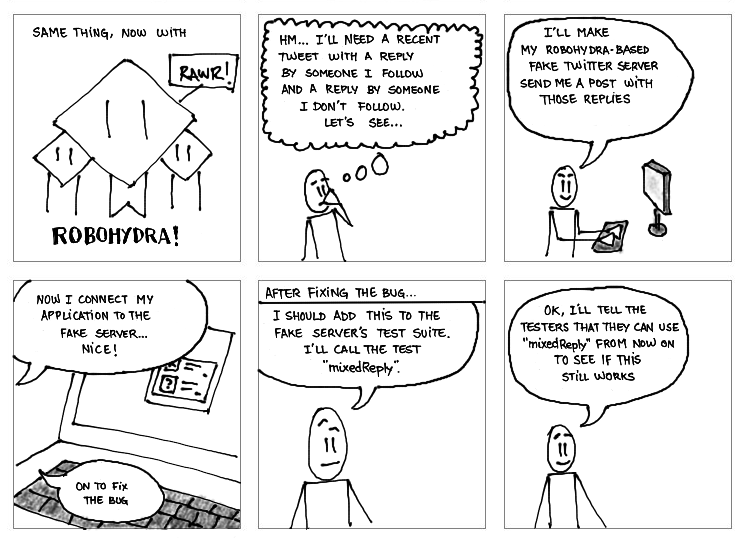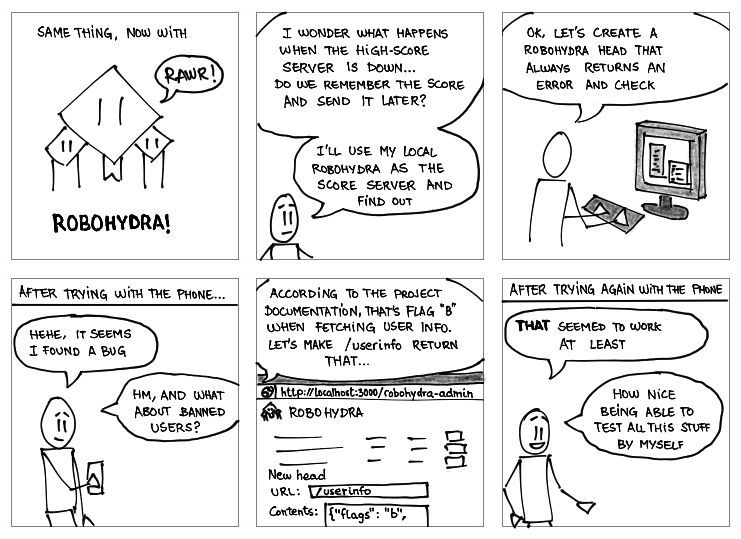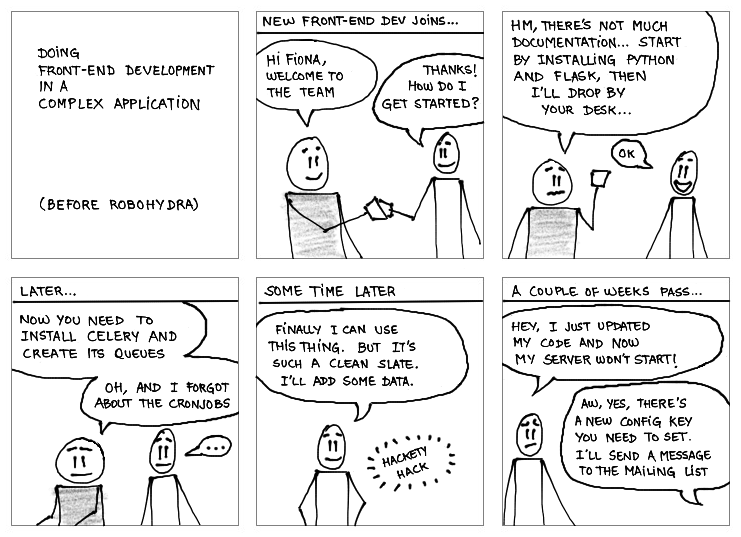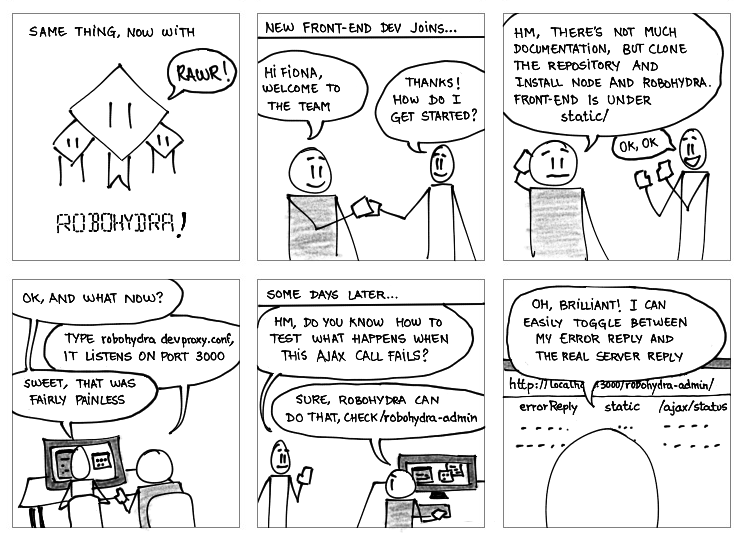RoboHydra can be used in many different ways. It’s closer to a “swiss army knife of client testing” than a very specific testing tool with a single purpose. Thus, it can be at first hard to tell whether or not RoboHydra can help you do what you want. The following is a list of use cases and examples of what RoboHydra can do: testsuites, exploratory testing, help test race conditions, help your front-end developers, and off-line testing and prototyping.
Often, testing the client side of a client-server project is cumbersome and time-consuming:

However, what if you could easily, instantly get whatever responses you needed from your server, plus you could save those special responses so that you can recall them later? With RoboHydra, you can:

It’s easy to configure a RoboHydra-based server to mimick any server behaviour needed to test your clients. Examples of this might be:
Testing how the client behaves when it receives a certain combination of valid (but possibly uncommon, cumbersome or even impossible to reproduce) data.
Being able to easily reproduce race conditions.
Checking how the client behaves when the server returns Internal Server Error or invalid data.
Simulating server connection latency when connecting to a real server.
So, let’s say you build a client of the Opera Link API and decide to build a test suite for it. The first step would be to identify what test cases are useful or interesting to test. In this case, let’s assume that what you want is to simulate a user data store with one Speed Dial and two bookmarks, one of the bookmarks having the same URL as the Speed Dial. In that case, these two RoboHydra heads would do the job nicely:
scenarios: {
duplicateUrlInSpeeddialAndBookmark: {
heads: [
new RoboHydraHeadStatic({
path: '/rest/speeddial/children',
// You can pass a Javascript object directly in "content":
// it will be converted to JSON
content: [
{
"item_type": "speeddial",
"id": "1",
"properties": {
"reload_interval": "2147483646",
"title": "Opera Portal beta",
"uri": "http://redir.opera.com/speeddials/portal/",
"reload_only_if_expired": "0",
"reload_enabled": "0"
}
}
]
}),
new RoboHydraHeadStatic({
path: '/rest/bookmark/children',
content: [
{
"item_type": "bookmark",
"id": "319A38DB4581426DA48CAB58C2528FD4",
"properties": {
"created": "2010-08-18T12:59:13Z",
"uri": "http://opera.com",
"title": "My first API bookmark"
}
},
{
"item_type": "bookmark",
"id": "419A38DB4581426DA48CAB58C2528FD5",
"properties": {
"created": "2010-08-18T12:59:13Z",
"title": "My first API bookmark",
"uri": "http://redir.opera.com/speeddials/portal/"
}
}
]
})
]
},
// ... Other scenarios ...
}Once you have your scenario defined, you can go to the scenario admin
interface (ie. http://localhost:3000/robohydra-admin/scenarios/) and
activate each one before starting it. Note that if your client was
web-based and you were automating your tests with something like
Selenium, you could easily change the current scenario by using the
REST API.
Maybe you’re not interested in building a “formal” test suite for your client, but would like to be able to reproduce certain situations easily. For this example, imagine you’re implementing a client for some API that specifies that, in order to allow for future extensions, all clients must ignore any attributes they don’t understand. As a tester, it would be great to have an easy and reliable way to test how your client behaves when it receives something that the current server never sends, but a future server might.
One possibility would be to use RoboHydra as a proxy to your normal
development or production server, and then create heads dynamically using
the admin interface (ie. http://localhost:3000/robohydra-admin/) to get
specific test responses for certain paths (say, temporarily override
path /api/widgets/1 to show some special testing data instead of
whatever your development or production server replies with).
Or imagine you’re testing a mobile application that sends the high scores to a server. There are many situations that are not necessarily easy to test if you use the real server:

By using RoboHydra as a server, though, many of those cases become very easy to test. More freedom for exploratory testing, happier testers and more reliable software:

Even if your “testing” doesn’t need any support, RoboHydra might come in handy to reliably reproduce hard-to-track bugs like race conditions. For example, let’s say you are building an application that uses two different servers: one for authentication and another one to retrieve application data from. Usually the authentication server replies before the client can manage to send the data retrieval request, but if it doesn’t, maybe the client will send the request with an empty or invalid user name.
RoboHydra allows you to set up this “race condition” in a reliable way, making the authentication request take a couple of seconds to respond, or maybe respond with an internal server error or not respond at all. This usage of RoboHydra might make it trivial to debug and fix errors that otherwise could take hours, if not days. Not to mention that once fixed, it will be much easier to verify the fix.
This simple head waits one second before serving requests for the
/authentication URL path:
new RoboHydraHead({
path: '/authentication',
handler: function(req, res, next) {
setTimeout(function() {
next(req, res);
}, 1000);
}
}),
// ... head that actually serves the
// "/authentication" path (eg. a proxying head) ...See “The next function” in the “RoboHydra heads” section in the documentation for more details.
Imagine you have a team split into front-end developers and back-end developers. If it’s a hassle for your front-end developers to install their own development back-end (eg. different platforms, many dependencies, front-end developers not familiar with the language or environment you’re using for the back-end, etc.), RoboHydra might be helpful.

One possiblity is to prepare a very simple RoboHydra plugin that serves the front-end files from the local disk, while all other paths are proxied. That would allow you to have a single development backend, but many front-end developers working on their own version of the front-end files independently of the rest. These two heads might do the trick:
new RoboHydraHeadStatic({
mountPath: '/js',
documentRoot: 'src/js'
}),
new RoboHydraHeadProxy({
mountPath: '/',
proxyTo: 'http://dev.myapp.example.com'
})
As this is such a common use of RoboHydra, there’s a plugin called
frontend-dev-proxy that does exactly that. See the “Standard
plugins” section in the documentation for more details.
In other situations, you might not have access to the server at all. Maybe you don’t have internet access, or you are outside of the intranet and don’t have access to a VPN, etc. In those cases, RoboHydra can be used to save the traffic sent by the server, and then replay it whenever you don’t have access to the internet.
RoboHydra comes with a simple replayer plugin for this. See the screencast or the “Standard plugins” section in the documentation for more details.